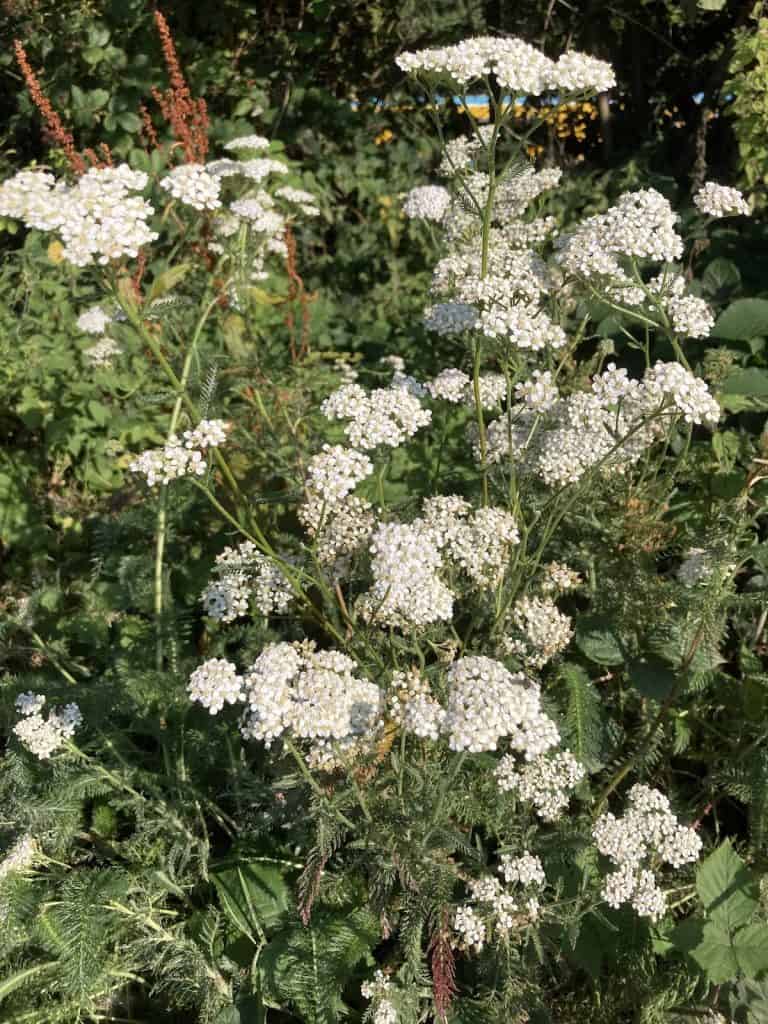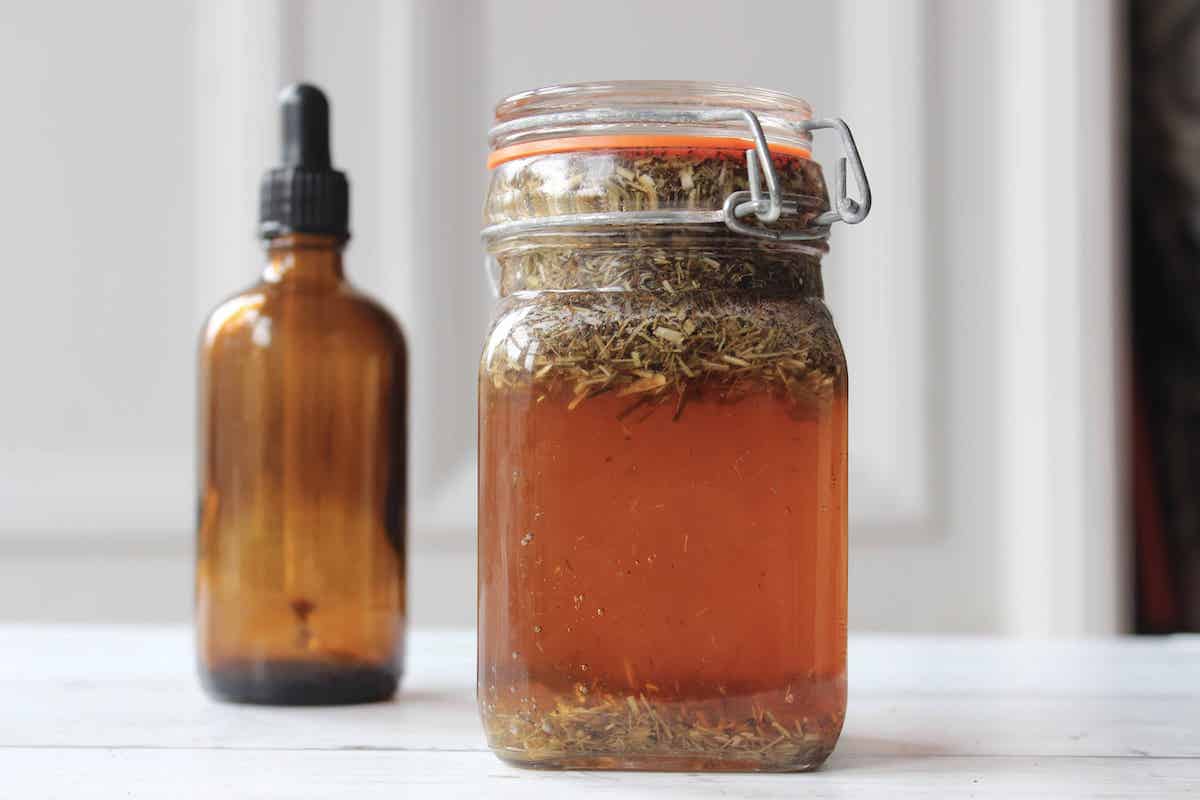Last Updated on August 17, 2025 by Nico
Yarrow is used to support wound healing, ease menstrual pain, reduce inflammation, and more. Learning how to make yarrow tincture is a great way to easily be able to preserve and consume the plant’s medicinal benefits.

Yarrow tincture is important to have amongst your herbal remedies. It’s most known for its ability to slow bleeding and help wounds to heal. But when consumed internally the plant also helps to fight off colds, reduce inflammation, and boost digestion.
Yarrow (Achillea millefolium) has been used medicinally for thousands of years, dating back to ancient Greece where it was used to help heal wounds. Native Americans used yarrow to help with fevers and reduce coughs, and it was used in European traditional medicine for everything from treating wounds to improving digestion.
The plant is part of the Asteraceae family, which is the same family as other medicinal plants like dandelions, chamomile, and echinacea.

Benefits of yarrow
Supports wounds to heal – Yarrow is a natural first aid remedy and can increase how quickly cuts and bruises heal and promote clotting of blood.
Anti-inflammatory – Flavonoids and other compounds in yarrow can help to reduce inflammation in the body. These compounds can help reduce the symptoms of arthritis, eczema, urinary tract infections, and other inflammatory diseases.
Antimicrobial properties – Yarrow contains flavonoids and volatile oils that give it antibacterial, antiviral, and antifungal properties that help fight infections.
Supports digestive health – Yarrow can improve digestion, and help with bloating and indigestion.
Reduce menstrual cramps – Yarrow can be used to ease cramping during menstruation and regulate the menstrual flow.
Supports the immune system – Compounds in yarrow support immune function and have antibacterial and antiviral properties.
Support circulatory health – Compounds in yarrow can improve circulation and support overall cardiovascular health. Yarrow can be used to help reduce pain and swelling of varicose veins due to its circulatory support.

When to harvest yarrow
If you are foraging wild yarrow, it is best to harvest the plant on a sunny day (to minimise moisture on the plant) in the mid-morning, before the hot afternoon sun reaches the flowers. This will ensure that the maximum amount of the plant’s essential oil is in the flowers and hasn’t been evaporated by the hot sun.

Which part of the yarrow plant to use
You can use the yarrow flowers, leaves, and stems to make yarrow tincture.
Contraindications of yarrow
Pregnancy – Yarrow is not recommended during pregnancy, as it can stimulate uterine contractions and may increase the risk of miscarriage.
Allergies to Asteraceae family – If you have allergies to plants in the Asteraceae/Compositae family (e.g., ragweed, chrysanthemums, marigolds, daisies), you might also be allergic to yarrow and should avoid using it.
Bleeding disorders – Yarrow can slow blood clotting, so it should be avoided by people with bleeding disorders.
Surgery – Due to its potential to slow blood clotting, it’s recommended to stop using yarrow at least two weeks before any scheduled surgery.

Yarrow tincture recipe
Tools
An airtight container with a tight-fitting lid – I use a glass mason jar with parchment paper between the metal lid and tincture or extraction to prevent the alcohol from corroding the metal.
Small amber glass bottles with dropper tops – I like these
A fine mesh strainer, cheesecloth, or coffee filter – I like these unbleached ones
A small funnel
A knife, food processor, or mortar and pestle – for chopping up fresh yarrow
Supplies
Fresh or dried yarrow – Here’s a source for dried yarrow (but it’s not organic)
80-proof vodka (or 40% alcohol) – If you want to avoid alcohol, you can swap out the alcohol for store-bought apple cider vinegar or food-grade glycerin. I buy this bulk raw apple cider vinegar. If you’re using fresh yarrow, consider using a high-proof alcohol, which will be more effective at preventing spoilage from the water content in the plant.
For complete measurements, see the printable recipe card below.

Instructions
Wash your fresh yarrow leaves, flowers, and stems and allow them to airdry overnight or pat them dry with a cloth.
Use a knife, food processor, or mortar and pestle to chop up fresh yarrow. We do this to maximise the surface area of the plant that is exposed to the alcohol.
Add the plant material to a clean glass mason jar. If you’re using fresh plant material, fill the jar ¾ of the way full. If you’re using dried yarrow, fill the jar ⅓ of the way full.

Cover the yarrow with 80-proof or above alcohol – I tend to use unflavoured vodka.

Add a piece of parchment paper between the jar and the lid, and then put a lid on the jar. Shake the jar to make sure everything is covered in alcohol. Set the jar in a cool (room temperature is fine), dry place away from direct sunlight.
If you used dried yarrow, top up your jar the following day to make sure everything remains below the alcohol.
Add a label and date so you don’t forget what it is and when you made it.
Let the jar sit for 6-8 weeks and try to shake it a few times a week to keep the yarrow submerged in alcohol.

After 8 weeks, use cheesecloth or a strainer to strain off the tincture.
Add the liquid extract to an amber glass dropper bottle. Don’t forget to date and label it so you don’t forget what it is.

How much yarrow tincture to take?
Digestive support – You can take 10-20 drops 1-2 times per day.
Menstrual pain relief – You can take 10-20 drops 2-3 times per day.
Immune support – You can take 20-30 drops 2-3 times per day.
You can start by taking small amounts and working your way up.
How long does yarrow tincture last?
Like many alcohol-based herbal tinctures, this tincture has a long shelf life. It will last a very long time if stored away from direct sunlight, in a dark place and the plant material has been completely strained off. I like to use the tincture within 1-2 years.
How to use yarrow tincture
Directly – You can add the tincture dosage under your tongue for the fastest absorption. Hold it there for 30 seconds and then swallow.
Diluted – You can add the dosage to a cup of yarrow tea (or other herbal tea), coffee, or water to dilute the flavour.
Topical use – There are a few external uses for yarrow tincture. You can apply yarrow-infused oil, yarrow salve, or diluted tincture directly to help with skin irritation and reduce pain from varicose veins. An easy way to do this is to add the dosage to a pump of lotion and apply it to the affected area.
How to make this without alcohol
You can simply swap the alcohol for store-bought apple cider vinegar or food-grade glycerin. Vinegar and glycerin aren’t as good as alcohol at extracting the beneficial compounds or preserving them. I like to consume vinegar-based extracts within about 6 months and glycerin-based extracts within a year.
I hope this post helps you feel confident to add yarrow tincture to your herbal medicine cabinet!
Disclaimer – I’m not a medical professional and do not intend to offer medical or health advice in any content I create. I offer information for educational purposes and, as always, get your physician’s advice or the advice of your healthcare provider before trying a new herbal remedy. There are always possible unintended consequences of trying a new herbal remedy such as an allergic reaction or unexpected side effects like interactions with other medication.
What to read next
Easy Goldenrod Tincture Recipe (For UTIs and Kidney Stones)
How To Make DIY Moringa Leaf Tincture (Organic Extract)
Simple Chicory Root Tincture Recipe
Save for later

This post may contain affiliate links, which means I make a small commission at no extra cost to you. As an Amazon Associate, I earn from qualifying purchases.
Find us elsewhere…
If you make this how-to and enjoy it, please consider giving it 5 stars. Find me on Instagram @documentingsimpleliving and show me what you’ve made!

How To Make Yarrow Tincture (DIY Healing Recipe)
Ingredients
Equipment
Method
- Wash your fresh yarrow leaves, flowers, and stems and allow them to airdry overnight or pat them dry with a cloth.
- Use a knife, food processor, or mortar and pestle to chop up fresh yarrow. We do this to maximise the surface area of the plant that is exposed to the alcohol.
- Add the plant material to a clean glass mason jar. If you’re using fresh plant material, fill the jar ¾ of the way full. If you’re using dried yarrow, fill the jar ⅓ of the way full.
- Cover the yarrow with 80-proof or above alcohol – I tend to use unflavoured vodka.
- Add a piece of parchment paper between the jar and the lid, and then put a lid on the jar. Shake the jar to make sure everything is covered in alcohol. Set the jar in a cool (room temperature is fine), dry place away from direct sunlight.
- If you used dried yarrow, top up your jar the following day to make sure everything remains below the alcohol.
- Add a label and date so you don’t forget what it is and when you made it.
- Let the jar sit for 6-8 weeks and try to shake it a few times a week to keep the yarrow submerged in alcohol.
- After 8 weeks, use cheesecloth or a strainer to strain off the tincture.
- Add the liquid extract to an amber glass dropper bottle. Don’t forget to date and label it so you don’t forget what it is.
Leave a Reply